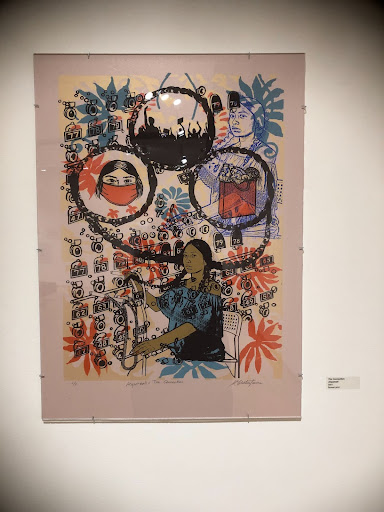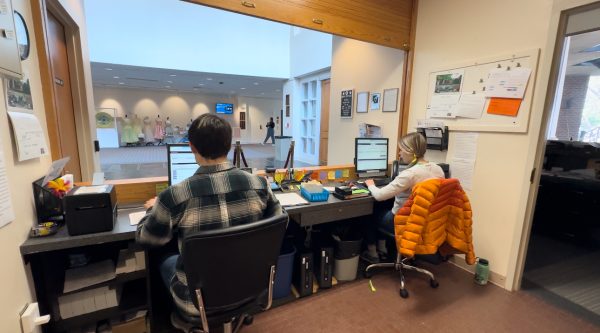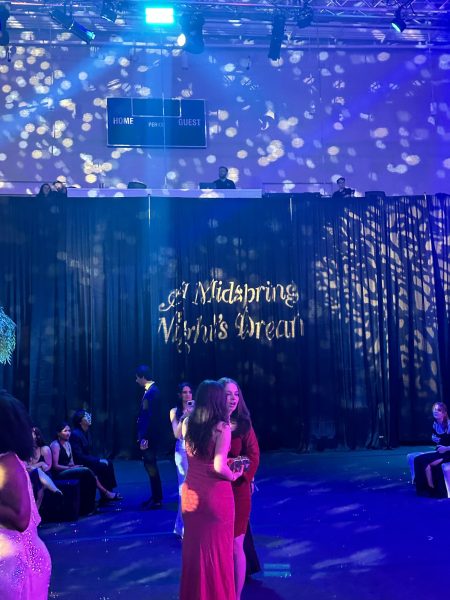Maria Christina Tavera explores multicultural identity through multimedia exhibit
The Mexican-American artist and activist uses cultural iconography to create her work.

Tavera’s exhibit was in Staniar Gallery from Nov. 8 to Dec. 3. Photo by Virginia Laurie, ’22.
December 14, 2021
On Nov. 16, Maria Christina “Tina” Tavera gave an artist’s talk on her exhibit “Homeward Bound,” featured in the Staniar Gallery from Nov. 8 to Dec. 3. The accomplished artist holds dual citizenship in the US and Mexico and uses Latin American iconography to explore her bicultural, bilingual identity in print, installation and video formats.
In addition to her diverse artistic practice, Tavera identifies as an activist. Tavera lives in Minneapolis, just several blocks from the street where Georg Floyd was murdered by Derek Chauvin in summer 2020. She spoke of the neighborhood rallying together to protect and memorialize the space.
“After the unrest, this memorial site was occupied for over a year by people who erected the barricades. The intersection became a place of pilgrimage where pan-ethnic solidarity for many people who wanted to protest George Floyd’s murder, but also other forms of racial injustice,” Tavera said.
Tavera was asked to design a billboard that would be visible from the corner from July to September 2021. She adapted her design from one of the screenprints in the exhibit, entitled “The Connection: Atquetzali,” which comes from a series based on her neighborhood, Powderhorn. Her design features an Indigenous woman operating a switchboard, and her long braids form three circles holding images of protesters, masks and groceries respectively.
Tavera joked about the use of a switchboard in her talk as she explained its deeper meaning.
“Now some of you, before the cellphone, before the landline, may remember that you needed to call the operator to place a call. So in those times, it was often women that were Latinas or Asian because they tended to be small in stature and could fit into a really small space, so they could fit many operators together,” Tavera said, “The braids represented the connections as I saw them when the community came together, and it really relied on their ability to mobilize during the crisis by communicating.”
Tavera went on to discuss specific community mobilization efforts such as a food drive where organizers collected over 30,000 bags of groceries, nearly filling the football field used to sort donations. When Tavera realized there was no food pantry to serve the Latinx community specifically, she got involved to make sure resources were evenly distributed.
“I was very honored to be part of this historical moment as I’m an interdisciplinary artist, and my art is informed by my work as an activist, and as cultural organizer,” Tavera said.
Tavera also discussed some of the prints inspired by her personal life and upbringing. As the eldest daughter of a bilingual, bicultural household, she found herself preoccupied with notions of displacement.
The struggle of migration and carrying culture with you is explored in the exhibit’s video installation. The looping video shows the lower half of a female figure in dress and heels walking across many different landscapes, including the desert, dragging an unidentified object on the ground behind her.
Tavera explained the story behind the mysterious video in her talk. She showed a childhood picture of her and her two sisters as children, standing in front of a Christmas tree. On the wall behind the tree is a big, bright God’s Eye, or Ojo de Dios. Tavera was intrigued by the juxtaposition and asked her mother about the large, distinctive object she remembered hanging in their living room. She learned it was a wedding gift that her mother brought with her from Mexico to the United States.
“The God’s Eye, Ojo de Dios, is a spiritual object made by weaving a design out of yarn on a wooden cross. I find a fascination with things that symbolize the merging of the European and Indigenous in the country of Mexico,” Tavera said.
Tavera went on to describe the powers of enhanced understanding and wisdom imbued in the God’s Eye and how they’re often found on trails and places of migration to help protect and assist travellers.
“Thinking about that made me come to realize that my mother’s journey was very symbolic in the same way, that Ojo de Dios was probably a symbol of protecting her while she was living in Minneapolis, far from her family,” she said.
She also mentioned the influence of Gloria E. Anzaldúa, a Chicana feminist writer well known for her conception of borderlands, wherein the US-Mexico border transcends a physical boundary and affects identity on a psychological level.
“My film title, Zozobra, refers to the emotions that are experienced during nepantla, the uncertainty and anguish, the restlessness of feeling a lack of belonging to some place due to the cultural upbringing,” Tavera said. “This is a common circumstance for many immigrants, or even Chicanos who are born in the US as Mexican-Americans, who experience spiritual insecurities.”
Tavera visited Professor Leigh Ann Beaver’s Printmaking I class, where she told students about her early arts practice and journey as a printmaker. Audrey Dietz, ‘23, appreciated the exhibit more after listening to Tavera’s in-class talk.
“It was cool how many media she used and seeing how it all came together after she talked to us,” Dietz said, “We saw her thought process behind the art, which was cool.”
The artist film “Zozobra” was one of Dietz’s favorite works.
“I was actually really drawn in by the audio as well as video aspect, which is interesting because I’m usually not into non-visual elements, but I watched that whole video like six times,” she said.
Fellow printmaking student, Carolina Rubio Regalado, ‘22, enjoyed the visit as well.
“I like that W&L brought a Latina artist to campus, and I liked all of her pieces, from the really big to the smaller ones,” Regalado said, “It was great to have her in class because she talked about her methods, and we were able to apply her technique of suicide prints into our class and our own work.”












